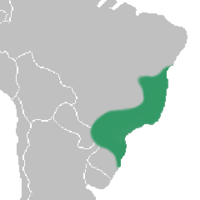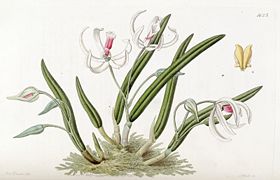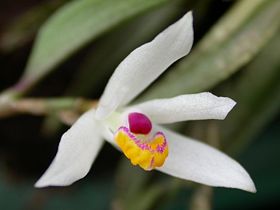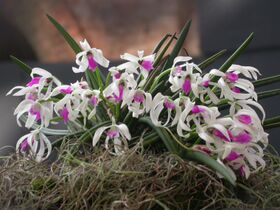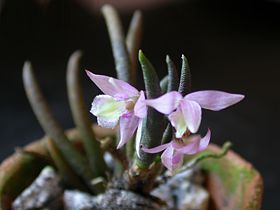Leptotes (orchid): Difference between revisions
imported>Chris Day |
imported>Chris Day |
||
| Line 49: | Line 49: | ||
The appearance of the [[petal]]s and [[sepal]]s is similar, both are elongated although the petals are slightly more narrow. Flower colors are generally greenish, white or variable shades of pink and the lip petal can be spotted in pale yellow, light purple or lilac. The lip is located along the [[Column (botanical)|column]] and trilobated (three lobes). The lateral lobes are small and raised beside the column, although never involving it. The intermediate lobe is much bigger and quite variable between the species. They can have either lanceolate or obovate shape, occasionally be fleshy, flat or bending backwards; in some species they have denticulated edges but are smooth in others; rarely calli are present and it has claws which hold it attached to the sides of the column. In the center the colomn is short, thick and erect, normally greenish, biauriculated, and bears six [[pollinia]] of different sizes, two larger in the center and four smaller in two pairs held by a short [[caudicle]] in an arrangement that is unique among orchids. Their [[fruit]]s are rounded, succulent and have a perfume reminiscent of ''[[Vanilla (Orchid)|Vanilla]]''.<ref><span style="font-variant:small-caps;">Withner, Carl Leslie</span>: '''The Cattleyas and Their Relatives, Vol. 3''', pp.94-95. Timber Press, Oregon. ISBN 0881922692</ref> | The appearance of the [[petal]]s and [[sepal]]s is similar, both are elongated although the petals are slightly more narrow. Flower colors are generally greenish, white or variable shades of pink and the lip petal can be spotted in pale yellow, light purple or lilac. The lip is located along the [[Column (botanical)|column]] and trilobated (three lobes). The lateral lobes are small and raised beside the column, although never involving it. The intermediate lobe is much bigger and quite variable between the species. They can have either lanceolate or obovate shape, occasionally be fleshy, flat or bending backwards; in some species they have denticulated edges but are smooth in others; rarely calli are present and it has claws which hold it attached to the sides of the column. In the center the colomn is short, thick and erect, normally greenish, biauriculated, and bears six [[pollinia]] of different sizes, two larger in the center and four smaller in two pairs held by a short [[caudicle]] in an arrangement that is unique among orchids. Their [[fruit]]s are rounded, succulent and have a perfume reminiscent of ''[[Vanilla (Orchid)|Vanilla]]''.<ref><span style="font-variant:small-caps;">Withner, Carl Leslie</span>: '''The Cattleyas and Their Relatives, Vol. 3''', pp.94-95. Timber Press, Oregon. ISBN 0881922692</ref> | ||
The agent for the [[pollination]] of ''Leptotes'' has never been observed. [[Cássio van den Berg]] postulates that bees are he primary agent due to the colors and morphology of its flowers<ref name="CBGO"/> while other orchidologists suspect | The agent for the [[pollination]] of ''Leptotes'' has never been observed. [[Cássio van den Berg]] postulates that bees are he primary agent due to the colors and morphology of its flowers<ref name="CBGO"/> while other orchidologists suspect pollination by [[hummingbird]]s is more important.<ref name="DM"/> | ||
==Taxonomic notes== | ==Taxonomic notes== | ||
Revision as of 01:38, 26 February 2009
| Leptotes | ||||||||||||||||||||
|---|---|---|---|---|---|---|---|---|---|---|---|---|---|---|---|---|---|---|---|---|
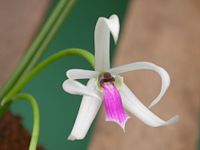 Leptotes bicolor
| ||||||||||||||||||||
| Scientific classification | ||||||||||||||||||||
| ||||||||||||||||||||
| Type species | ||||||||||||||||||||
| Leptotes bicolor Lindl. 1833 | ||||||||||||||||||||
| Species | ||||||||||||||||||||
| ||||||||||||||||||||
| Synonym | ||||||||||||||||||||
|
None |
Leptotes is a genus of orchids formed by nine small species that grow in the dry jungles of South and Southeast Brazil, and also in Paraguay or Argentina. They are small epiphytic plants of caespitific growth, that sometimes resemble little Brassavola, as they share the same type of thin terete leaves, however, they are more closely related to Loefgrenianthus.
Some species of Leptotes are widely cultivated and form showy displays when completely in bloom although they are not among the easiest to grow. The majority of the species are not cultivated and some are so rare to be almost unknown; five of the species have only recently been described since 2000. Beside being cultivated for their ornamental value, there are records of the flowers and fruits of Leptotes bicolor being used as a substitute for vanilla in milk, ice cream, tea and candies.[1]
Distribution
The species of Leptotes were originally discovered in the Atlantic Forest of Brazil and are always seen living epiphytically. Two species have since been found in other countries, L. unicolor in Argentina, and L. bicolor in Paraguay. Three species show a high degree of endemism in the south of Bahia State, these do not exist in any other place. The states of southeastern Brazil have the most species of Leptotes, however, the range is from the Serra da Jibóia chain of mountains, in Bahia, to the North of Rio Grande do Sul State.[2] It is assumed that L. mogyensis is a variety collected by Krakowizer found at Mogy das Cruzes, although this has not been verified as Christenson only worked with specimens under culture in the US.
The species in the group characterized by wide open flowers, such as Leptotes tenuis and L. pauloensis, are more frequently found in cloud mountain forests. L. bicolor has the broadest range and can survive in both the cloud mountanin forests and the dryer woods on the plateaus of the Serra do Mar chain of mountains. Leptotes unicolor grows optimally in cooler areas, above 700 meters of altitude, and is frequently found growing on Araucaria and Podocarpus trees in the southern areas of Brazil.[2]
Description
Species assigned to the genus Leptotes have a short rhizome of cylindrical section. They have small pseudobulbs that almost imperceptibly prolongate in one, rarely two, terete fleshy leaves. They have variable characteristics and can be short or long, erect or hanging, dark green or purple colors, frequently have a wrinkly surface and a deeper ridge in the face. The inflorescence is apical, generally short, and grows from the apex of the pseudobulb without a protecting spathe and bears up to seven flowers, although fewer are more common. The flowers are relatively large when compared to the overall plant dimensions, normally partially bent and in some species forming groups with a very showy aspect.[2] They are fragrant and this perfume can last from ten to twenty days.[3]
The appearance of the petals and sepals is similar, both are elongated although the petals are slightly more narrow. Flower colors are generally greenish, white or variable shades of pink and the lip petal can be spotted in pale yellow, light purple or lilac. The lip is located along the column and trilobated (three lobes). The lateral lobes are small and raised beside the column, although never involving it. The intermediate lobe is much bigger and quite variable between the species. They can have either lanceolate or obovate shape, occasionally be fleshy, flat or bending backwards; in some species they have denticulated edges but are smooth in others; rarely calli are present and it has claws which hold it attached to the sides of the column. In the center the colomn is short, thick and erect, normally greenish, biauriculated, and bears six pollinia of different sizes, two larger in the center and four smaller in two pairs held by a short caudicle in an arrangement that is unique among orchids. Their fruits are rounded, succulent and have a perfume reminiscent of Vanilla.[4]
The agent for the pollination of Leptotes has never been observed. Cássio van den Berg postulates that bees are he primary agent due to the colors and morphology of its flowers[2] while other orchidologists suspect pollination by hummingbirds is more important.[3]
Taxonomic notes
In April of 1833, it blossomed in the greenhouse of Mrs. Arnold Harrison, English collector of orchids homaged in diverse descriptions of noted species such as Bifrenaria harrisoniae and Cattleya harrisoniana an unknown species that she had received from Serra dos Órgãos mountains, in Brazil. Little time later, Mrs. Harrison sent a drawing and cut of this plant to the botanist John Lindley, who verified to be a not only a new species but yet new genus. In its description, dated of the same year, Lindley suggests the name of Leptotes, of Greek, mild, delicate, in reference to the appearance of the flowers of this plant. He affirms that Leptotes is similar and close to Tetramicra from which it is distinguished by the structures of the pollinarium and by the lateral lobes of the lip of its flowers, much smaller; and because they have no calcar attached to the ovarium. He also explains that from Brassavola it can be differentiated by the pollinia and trilobed lip. Then Lindley describes its type-species, Leptotes bicolor.[5]
In 1838, Lindley received two similar but slightly different plants, collected in Macaé de Cima and Ilha Grande, in Rio de Janeiro. Considering them different of the previously described species, because the lateral lobes of lip were slightly serrated, because their flowers were bigger, and also because they occasionally had a second leaf by pseudobulb, proposed a new species with the name of Leptotes serrulata.[6] Five years later, the German Count Johann Centurius von Hoffmannsegg, considering that the leaves of one plant he cultivated presented a different green-bluish tone, described the plant calling it L. glaucophylla.[7] When reviewing all the known species Leptotes at the time, in 1990, Carl Leslie Withner, opposing diverse previous taxonomists, who already had noticed the great similarity of all the species described so far, goes yet further and, based on the drawings published by Lindley, finds additional differences between L. bicolor and L. serrulata, affirming that second always bears many more flowers, with up to seven flowers for inflorescence, which is also much longer. [8] Today we know that both descriptions are of slight variations of L. bicolor, that, for its ample dispersion and multiplicity of populations, is a much variable plant.[9]
In 1865, Heinrich Gustav Reichenbach, received, from some unknown locality in Brazil, the second described species to be accepted today, a plant much different from Leptotes bicolor, because of its fewer and smaller rounded flowers, with wide open pale yellowish segments. He published it as L. tenuis.[10] Twelve years later, the third species, Leptotes unicolor, was described by Brazilian Botanist João Barbosa Rodrigues. According to the author, it was a much perfumed little species which he found some colonies with hundreds of plants living epiphyticaly along the banks of rivers Dourado and Sapucai, nearby the city of Alfenas, in Minas Gerais.[11] In 1881, Barbosa Rodrigues found another plant with longer leaves and slight diferences on floral structure, in Joinville, a city that at the time belonged to Paraná State, but today is located in Santa Catarina which didn't exist then, and described it as L. paranaensis.[12] Today this species is considered to be just a variation of L. unicolor he described four years earlier.[13]
Eight years later, Robert Allen Rolfe received form Brazil, also without information of locality, a plant similar to Leptotes tenuis which Reichenbach described in 1865, however, with much thicker and shorter leaves. Rolfe described it as L. minuta.[14] In his revision of Brazilian orchid species, published 1903, Célestin Alfred Cogniaux, ignoring the variability of Leptotes species, both because of populations insolation and because of the variability of lenght and thickness of leaves due to diferent degrees of light exposure on each habitat, accepted this species which we know today is just a variation of L. tenuis. Cogniaux did not have the opportunity to check the types of all other species then described, therefore, he accepted most of them with this remark.[15]
Johan Albert Constantin Loefgren, the Swedish Botanist living in Brazil, received from Itatiaia, Rio de Janeiro, in 1918, one orchid with with pending habit, thin flat leaves, and flowers that rememinded the ones of Leptotes, although its lips formed a pouch. He described it as Leptotes blanche-amesiae.[16] Later Frederico Carlos Hoehne concluded this species, despite closely related, might be better placed in another genus thus, as an hommage to Loefgren, proposed the genus Loefgrenianthus to accomodate it.[17] Hoehne also described a new species, Leptotes pauloensis, naming it so because is was found in São Paulo State, in 1934. This species is close to
Leptotes tenuis but has flowers of diferent colors. During decades taxonomists were not sure if this was to be considered a good species indeed. Guido Pabst considered it as a synonym of the later;[13] in 1990 Withner claimed that after being desappeared for many years, finally the doubts about its status were cleared as many had been found and it really should be accepted as good.[8]
Therefore in 2004 four species of Leptotes were known, three sufficiently different to each other and well stablished, L. bicolor, L. unicolor and L. tenuis, and one fourth, L. pauloensis, occasionally considered synonym of the previous one, but more frequently accepted by taxonomists. In this year, the species number doubled as other four were described. However, the history of these descriptions starts much earlier, in 1954, when one of the associates of Círculo Paulista de Orquidófilos, an orchid society in São Paulo, presented a lecture where he talked long and informally about the innumerable varieties of Leptotes that he found and gathered throughout the years and the names he particularly atributed to each. This lecture was printed and distributed in the bulletin of the association.[18] In 2004, Eric A. Christenson, aware of this publication, found in culture in particular collections in the United States two of the several varieties mentioned in the lecture and decided to describe them formally as independent species. One of these plants, Leptotes harryphillipsii, is very similar to L. pauloensis already a problematic species by itself.[19] The other one, L. mogyensis, is an unknown species to Brazilians, both scholar and collectors, except for the plant Christenson found in the US, supposedly originated from Mogi das Cruzes, a city nearby São Paulo.[20]
The other two species described in 2004 belong to the affinity of Leptotes bicolor and have been both found by the same surveyor in the region of Buerarema, south of Bahia. Leptotes bohnkiana , which name is a homage to its finder, can be differentiated because of its smaller size,[21] the other, L. pohlitinocoi, mostly by color.[22] Finally, in 2006 Sidney Marçal de Oliveira discovered the last species to be described, also from Bahia, although inhabitant of Chapada Diamantina, Leptotes vellozicola is much diferent from all the other species.[23]
Phylogeny
According to Cássio van den Berg et al., Leptotes is very closely related to Loefgrenianthus and both situated between Pseudolaelia and the genus which once used to be classified as Schomburgkia, by some now considered part of Laelia.[24]
Species
The three main characteristics that differentiate between the species of Leptotes are the general proportions of the leaves, the shape of the flowers and way the flowers open. Using these differences the species can be classified into two main groups.
One group is formed by the four species with flowers of elongated segments, which generally are not widely open. These species use to present malleable inflorescences that leave the flowers slightly or very overthrown, frequent facing down. Almost all the species of this group have long leaves, of comparatively lighter tones, generally with smooth surfaces, longer than the inflorescences.
- Leptotes unicolor is the exception in this group as it has short, wrinkly and dark leaves. Its flowers, of generally uniform pale pink, always face down. The other species of this group have flowers of stronger colors.[25]
- Leptotes bicolor is the species with more flowers per inflorescence and with wider distribution. It is a much variable species, even tho easily recognizeable because of its bicolored flowers, of white sepals and petals and purple lip, occasionally bearing two leaves per pseudobulb. There are some records of this species living as a lithophytic.[3]
- Leptotes bohnkiana is similar to L. bicolor, however, its flowers measure only one third of the dimensions of the second ones, with segments proportionally wider, the plant measures only one half. All the plants found had only one flower per inflorescence. It just exists in Bahia.[21]
- Leptotes pohlitinocoi is even closer to L. bicolor but has slightly smaller flowers with all segments completely pink. It just exists in Bahia.[26]
The other group is formed by five smaller species with more rounded flowers of wide open flatter segments and much shorter wrinkly leaves, generally very dark green or purple colored. The species of this group often have only one or two flowers each inflorescence. Four of them are much similar and sometimes difficult to distinguish.
- Leptotes vellozicola is the only easily recognizeable species in this group as it has a thick central callus next to the lip apex. It is the only species of this group endemic of Bahia, all the other are from Southeast and South Brazil.[23]
- Leptotes tenuis is the only Leptotes species with pale green, yellowish or white flowers and lilac lip. It is a very small and uncommon species from Southeastern States of Brazil.[27]
- Leptotes pauloensis is a species very similar to the previous one and can be separated from it mainly by the color of the floral segments, which are inverted here, that is, pale lilac petals and sepals and white lip with a yellowish cream mark in the middle. Its distribution overlaps L. tenuis but extends much more into South.[28]
- Leptotes harryphillipsii, another similar species to the previous, however with slightly longer lip and discrete pink stripes on the other segments, which shows a little more vibrant colors. It seems this species has been known for long time but has been always confused with the true L. pauloensis.[19]
- Leptotes mogyensis, yet another species closely related to L. tenuis but always bearing white flowers with a deep purple central mark on the lip. There is no record of this plant in the wild. All information comes from a plant found under cultivation in the USA.[20]
Culture
As the roots of Leptotes rot easily with excessive humidity, the best results for their culture are achieved when they are mounted on plaques of vegetal fiber or tree cork. Watering and fertilizer must be more frequent during active growth periods and less during dormant periods. Ideal growth conditions require an intermediate temperature and exposure to filtered sunlight.[29]
References
- ↑ Lawler, L.J.: Ethnobotany of the Orchidaceae in Orchid biology: reviews and perspectives, Vol.3. J. Arditti Ed., Cornell University Press, Ithaca, New York, 1984.
- ↑ 2.0 2.1 2.2 2.3 Van den Berg, Cássio: Leptotes in Genera Orchidacearum Vol.4, pp. 271-3. Oxford University Press, 2006. ISBN 9780198507123.
- ↑ 3.0 3.1 3.2 Miller, David; Richard Warren; Izabel Moura Miller & Helmut Seehawer: Serra dos Órgãos sua história e suas orquídeas, p. 240. Rio de Janeiro, 2006.
- ↑ Withner, Carl Leslie: The Cattleyas and Their Relatives, Vol. 3, pp.94-95. Timber Press, Oregon. ISBN 0881922692
- ↑ Lindley, John: Leptotes bicolor in Edward's Botanical Register Vol.19, t.1625. James Ridgway & Sons Ed. London, 1833. Published on internet.
- ↑ Lindley, John: Leptotes serrulata in Sertum orchidaceum, t.11. James Ridgway & Sons Ed. London, 1838. Published on internet.
- ↑ Hoffmannsegg, Johann Centurius von: Leptotes glaucophylla in Botanische Zeitung Vol.1, p. 833. Berlin, 1843.
- ↑ 8.0 8.1 Withner, Carl Leslie: The Cattleyas and Their Relatives, Vol. 3, p.96. Timber Press, Oregon. ISBN 0881922692
- ↑ Govaerts, Rafaël et al: World Checklist of Orchidaceae. The Board of Trustees of the Royal Botanic Gardens, Kew. Published on Internet (Access in January 2009).
- ↑ Reichenbach, Heinrich Gustav: Leptotes tenuis in Hamburger Garten Blumenzeitung Vol.21, pp. 296. Hamburg, 1865.
- ↑ Barbosa Rodrigues, João: Leptotes unicolor in Genera et species orchidacearum novarum Vol.1, p.74. 1877. Published on Internet, in French and Latin.
- ↑ Barbosa Rodrigues, João: Leptotes paranaensis in Genera et species orchidacearum novarum Vol.2, pp.163. 1881. Published on Internet, in French and Latin.
- ↑ 13.0 13.1 Pabst, Guido & Dungs, Fritz : Orchidaceae Brasilienses vol. 1 p. 148, Brucke-Verlag Kurt Schmersow, Hildesheim, 1975. ISBN 3871050106
- ↑ Rolfe, Robert Allen: Leptotes minuta in Gardeners' Chronicle Vol.1889-2: p. 323. London, 1889.
- ↑ Cogniaux, Célestin Alfred: Leptotes in Flora Brasiliensis Vol.3 Part.6: pp. 254-259. K.F.P. von Martius Ed., 1903. Published on Internet, in Latin.
- ↑ Loefgren, Johan Albert Constantin: Leptotes blanche-amesiae in Arquivos do Jardim Botânico do Rio de Janeiro Vol.2: p. 58. Rio de Janeiro, 1918.
- ↑ Hoehne, Frederico Carlos: Loefgrenianthus in Arquivos de Botânica do Estado de São Paulo Vol.1: p. 593. São Paulo, Julho de 1927.
- ↑ Krackowizer, F. J.: Monografia do gênero Leptotes in Revista do Círculo Paulista de Orquidófilos Vol.11, pp. 53-63 e 64-72. São Paulo, 1954.
- ↑ 19.0 19.1 Christenson, Eric A.: Leptotes harryphillipsii in Orchids South Africa Vol.35, pp. 53. Cape Town, 2004.
- ↑ 20.0 20.1 Christenson, Eric A.: Leptotes mogyensis in Orchids South Africa Vol.35, pp. 54. Cape Town, 2004.
- ↑ 21.0 21.1 Campacci, Marcos Antonio: Leptotes bohnkiana in Boletim CAOB Vol.53, p.17. São Paulo, 2004. ISSN 14194590.
- ↑ Vitorino P. Castro Neto & Chiron, Guy: Leptotes pohlitinocoi in Richardiana Vol.4: p.78. Paris, 2004.
- ↑ 23.0 23.1 Van den Berg, Cássio et al: Leptotes vellozicola em Neodiversity Vol.1, pp. 2, 2006. Publicado na Internet, em inglês.
- ↑ Van den Berg, Cássio et al: A Phylogenetic analysis of Laellinae based on sequence data from internal trancribed spacers of nuclear ribosomal DNA in Lindleyana vol.15-2, pp. 96–114, 2000. Published on Internet.
- ↑ Johnson, Andrés E.: Leptotes unicolor in Las orquídeas del Parque Nacional Iguazú, pp. 110. Fundación Vida Silvestre Argentina, Buenos Aires, 2001. ISBN 9509725412
- ↑ Vitorino P. Castro Neto: Leptotes pohlitinocoi in Icones Orchidacearum Brasilienses Vol.2: pl.163. São Paulo, March 2006. ISBN 8590149447
- ↑ Vitorino P. Castro Neto: Leptotes tenuis in Icones Orchidacearum Brasilienses Vol.2: pl.164. São Paulo, March 2006. ISBN 8590149447
- ↑ Vitorino P. Castro Neto: Leptotes pauloensis in Icones Orchidacearum Brasilienses Vol.2: pl.162. São Paulo, March 2006. ISBN 8590149447
- ↑ Pridgeon, Alex: Leptotes in Genera Orchidacearum Vol.4, p. 274. Oxford Unity Press, 2006. ISBN 9780198507123.

